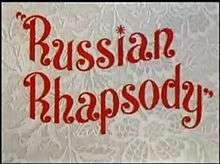Russian Rhapsody (film)
| Russian Rhapsody | |
|---|---|
| Merrie Melodies series | |
 | |
| Directed by | Robert Clampett |
| Produced by | Leon Schlesinger |
| Story by | Lou Lilly |
| Voices by | Mel Blanc (uncredited) |
| Music by | Carl Stalling |
| Animation by |
Rod Scribner Robert McKimson |
| Studio | Leon Schlesinger Productions |
| Distributed by | Warner Bros. Pictures |
| Release date(s) | May 20, 1944 (USA) |
| Color process | Technicolor |
| Running time | 7 minutes 1 second |
| Language | English |
Russian Rhapsody is a 1944 Warner Bros. cartoon directed by Bob Clampett, under the Merrie Melodies series.
Made during World War II, the cartoon mocks Adolf Hitler, showing him defeated by "gremlins from the Kremlin." The wordplay symbolizes the Soviet Union, a vital ally of the Allied forces.
The original title was "Gremlins from the Kremlin", but producer Leon Schlesinger changed the title when The Walt Disney Company began making its own wartime short about gremlins. In Falling Hare, Bugs Bunny was the victim, while Hitler is the victim and main character in this short.
Synopsis
German bombers are failing to make it to Moscow in World War II, so Hitler announces his decision via a radio broadcast at a "New Odor" rally to personally fly a heavy bomber to attack the Russians. On the way to Moscow, Soviet gremlins sneak onto the plane in flight and without Hitler’s being aware of what's going on, begin to dismantle it while singing "We Are Gremlins from the Kremlin" to the tunes of “Ochi Chyornye” (“Dark Eyes”) and “Eh, uchnem” (“Song of the Volga Boatmen”), and the sabotage includes a "termiteski" busily devouring the plane's wing (with loud burps) and a microscopic gremlin smashing the control panel dials with an enormous wooden mallet and announcing "I'm only three and a half years old!"
Hitler eventually discovers the gremlins after he's been stabbed in the buttocks and tries to retaliate. He fails, being severely frightened by several gremlins holding a mask of Joseph Stalin. The gremlins succeed in ejecting him from the bomber by cutting a hole in the fuselage beneath him. As he falls, Hitler comes to and realizes the plane is right behind him in a power dive. He tries to outrun the plane and to hide behind a small sapling upon landing, but the plane alters course as seen by its shadow. Both Hitler and the plane are driven into the ground. The plane’s tail with its swastika insignia erupts from the ground as a headstone.
The cartoon ends with the gremlins celebrating in victory as Hitler pops out of the ground, with his face grimacing into the one of comedian Lew Lehr, and paraphrasing his famous catch phrase: "Monkeys is the cwaziest [craziest] peoples!" (only changing the word "monkeys" into "Nazis"). A gremlin pounds Hitler back into the ground with a sledgehammer, ending the film under Clampett’s signature ‘‘bee-woop’’ vocalization.
Production
- Many of the gremlins are caricatures of the Warner Bros. animation department staff. The style is reminiscent of a 1936 Christmas card showcasing the staff as drawn by T. Hee. Among the recognizable gremlins are Chuck Jones, Robert Clampett, Friz Freleng, Melvin Millar, Michael Sasanoff, Leon Schlesinger (who is shown tapping the heads off of rivets with a hammer as he’s being raised by a rope with Napoleon's hairstyle) Michael Maltese, Carl Stalling, Henry Binder and Ray Katz. Freleng and Binder are also referenced during Hitler’s fake German rant at the beginning of the cartoon. Also referenced is What's Cookin' Doc? (also directed by Bob Clampett).
- In the scene of Hitler going after the gremlins, there’s a strange jump between Hitler screaming at the sight of a Stalin-type mask. The next scene shows the gremlins sawing a hole in the plane to get rid of a semi-conscious Hitler. It’s unknown if a missing scene between those scenes exists.
- The lyrics reference the 1942 Disney cartoon and the 1942 song (composed by Oliver Wallace and recorded by Spike Jones) both titled Der Fuhrer's Face.
- The gag showing a gremlin swapping windshield stickers is a reference to wartime U.S. gasoline rationing.
Availability
This cartoon is included in disc two of Looney Tunes Golden Collection: Volume 6. The disc consists mainly of wartime cartoons mostly made during World War II. It is also available on Looney Tunes Platinum Collection: Volume 2, disc two.
Due to its sensitive nature and its depiction of Nazis, the cartoon is often removed from circulation on TV, barring select instances of wartime cartoon airings.
See also
External links
- Russian Rhapsody at the Internet Movie Database
- Russian Rhapsody at The Big Cartoon DataBase
- Russian Rhapsody on the Internet Archive